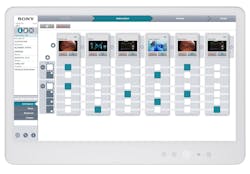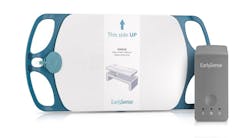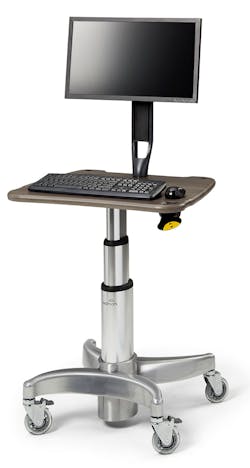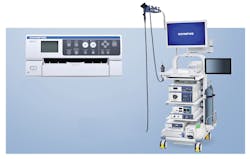Medical displays and monitors move forward with momentum
The world continues to watch the impact of the COVID-19 pandemic on people’s health and lives. Hospitals and healthcare facilities channel their efforts and resources around the clock to patient care for COVID-19-related and other medical conditions.
Particular equipment, like medical grade displays and monitors, have become a necessity in critical care during this crisis. Manufacturers press forward to make advancements and ensure availability of these devices for clinicians and staff to use in hospital, non-acute care, post-acute care, and remote work environments.
Resourcefulness and flexibility
“We focused on protecting our workers and maintaining business continuity, especially minimizing supply chain disruptions,” Impellizeri explained. “LG leveraged its global supply chain and prepared in the early stages of the pandemic with dedicated resources to produce enough medical monitors to prepare for the worst to come. LG understood medical monitors are essential to hospitals on the front lines of the pandemic. So, it was vitally important LG could fulfill orders in a timely manner.”
Some hospitals rearranged workspaces to accommodate care during the pandemic, observes Anne Bondulich, Marketing Manager, Sony Electronics.
“Over the past few months, the need for critical care rapidly emerged as OR’s were quickly turned into ICUs,” Bondulich described.
Other facilities that shut down are poised to reopen, notes Brian Schlueter, Senior Marketing Manager, FSN Medical Technologies.
“At the height of the pandemic, the focus of medical facilities was COVID-19-related, and other procedures were given less priority,” Schlueter indicated. “As infection rates trend downward, and facilities equip to contain the virus, elective surgery volume will likely increase, including the demand for new capital equipment and upgrades.”
Going virtual and remote
Workforces, technology, and work settings modified to support the safest possible care and service.
“Going forward, less contact between staff and patients is a strict requirement to help stop the spread of disease,” Bondulich said. “Facilities are focusing on solutions that can quickly help them adapt now and in future crisis situations. One such solution is the Sony NUCLeUS video-over-IP system combined with Sony’s PTZ cameras and 4K displays, which allow nurses’ workstations to easily and remotely add live view access into any room, whether a surgical suite, ICU or emergency department, to reduce exposure and minimize personnel required in a confined space.”
She continued, “Due to distancing measures and infection control, there is a very high demand for advanced telemedicine solutions in hospitals, particularly in the ICU and critical care areas. Now more than ever, Sony’s pan tilt zoom cameras are being integrated into leading telemedicine platforms in hospitals to collaborate and communicate virtually.”
In some cases, medical staff shifted to remote care and equipment, Impellizeri pointed out.
“During the pandemic, many radiologists have been working more from home,” he noted. “Radiologists scrambled to set up their home offices with the same image quality, diagnostic confidence and reliability as they experience in the hospital’s reading room. Many turned to us for lightweight, high-performance LG Gram laptops (17Z90N) and DICOM compliant 8MP diagnostic monitors (31.5-inch model 32HL512D-B).”
“We increased production of our products, but COVID restrictions reduced our workforce by 25% initially,” she stated. “We were able to offset these limitations with increased overtime for the remaining team. In many facilities, our local clinical specialists were able to continue assisting with installation and training on our products. In other facilities, we offered virtual trainings, which were a flexible and efficient option for our customers.”
Hospital-wide and specialty care
Video imaging is used across various healthcare settings and specialties. Monitors of all sizes and capabilities are needed.
“Primary areas that require display of video images include endoscopy, laparoscopy, arthroscopy, fluoroscopy, surgical microscopes, and ophthalmology,” Schlueter addressed.He added, “FSN’s 55” and 58” monitors have multiple video signal inputs compatible with a variety of image-capture devices as well as the images produced by monitoring equipment found, for example, in a cath lab. FSN also offers wireless A/V transceivers, recording and archiving equipment, video over IP, multi-viewers for video wall-type needs, signal routing and signal conversion devices, optical fiber cables and other equipment to support infrastructure in the OR.”
Patients are monitored in a growing number of environments, expresses Tim O’Malley, President & Chief Growth Officer, EarlySense.
“Historically, higher acuity areas including ICUs, operating rooms and recovery areas have used patient monitoring technology,” he indicated. “However, today the use of patient monitoring has expanded to non-acute areas in the hospital, with med-surg and general floors using it as a continuous way to detect changes in patients prone to health complications. Now, beds in general care areas have advanced, robust sensors embedded within them, allowing for most hospital patients to be monitored. Outside of the hospital, there is a rapid adoption of sensor-based monitoring technology in post-acute facilities, and a rapid expansion into the home. With EarlySense’s contact-free continuous monitoring technology, a sensor placed under a patient’s mattress can accurately transmit real-time data to medical staff outside the patient’s room, which is extremely useful in light of the recent coronavirus social-distancing restrictions.”
COVID-19, in turn, created a greater need for monitoring high-risk patients, emphasized Szyman.
“The COVID-19 pandemic caused many hospitals to expand ICUs to treat the overwhelming number of cases, which created demand for monitoring technologies,” she explained. “Because these patients have a higher risk of developing serious complications, hemodynamic monitoring can help clinicians detect problems quickly, enabling them to make more informed and immediate treatment decisions.”
“Today’s equipment must be designed to provide the flexibility needed to support technology within the exam room, from room to room, when a space-saving solution is needed—or when it’s time to expand the point of care beyond the exam space, such as the shift to telehealth resulting from the COVID-19 pandemic,” Hazelwood stressed. “Mobile and stationary workstations are designed with technology needs in mind, whether a desktop, laptop or tablet-based technology component is used. Fully adjustable monitor arms enable monitors to easily be positioned for sitting and standing postures, eliminating neck and eye strain. Dual monitor mounts also are available to support software needs.”1
These types of workstations also are essential in surgical settings and procedures. Olympus, for example, announced in a press release, “the introduction of two new products designed to enhance patient care in endoscopy and surgical imaging by improving procedural workflow: the OEP-6 high-definition printer and the WM-NP3 workstation.”
The company continued, “The OEP-6 high-definition printer accurately reproduces HDTV images to produce high-definition prints with excellent quality for endoscopist use during patient or colleague consults as well as detailed record keeping. The WM-NP3 workstation has been designed to specially support and add value to current and future imaging systems. It features an increased loading capacity, while taking up less floor space and supporting an expanded range of accessories.”
Trending technology
Medical display and monitoring technology continuously adapts to fulfill the many needs in care.
For example, LG Business Solutions focuses on the growth of its surgical and radiology monitors as well as X-ray imaging, Impellizeri explained.
“The antimicrobial additive used in LG medical monitors is especially important given the multitude of challenges in achieving and maintaining the adequate cleanliness required of healthcare facilities. In addition to medical monitors, LG also is committed to image acquisition with our Digital X-Ray Detectors.”
Advancements in imaging resolution is another key concentration, Bondulich indicated.
“One of the biggest trends in imaging is the transition from HD to 4K resolution, which has greatly improved visualization for medical professionals during surgery and post-procedure. 4K 3D monitors can be paired with Robotic systems, to offer increased immersivity and depth of field, and High Dynamic Range (HDR), to deliver dramatic contrast with more brightness, accurate shadow detail, and deeper blacks.”
An additional focus is integration of artificial intelligence in monitoring and data collection, Szyman said.
“Artificial Intelligence is a significant development in displays and monitors, enabling the monitor to not only provide information about how the patient is doing now, but also to provide predictive information about how the patient will be doing in the future. For example, we recently introduced our Hypotension Prediction Index that can predict when a patient will have a dangerously low blood pressure event before it happens.”
References:
1. Olympus Introduces the OEP-6 High-Definition Printer and WM-NP3 Workstation, https://www.olympusamerica.com/corporate/corp_presscenter_headline.asp?pressNo=3232
Next-generation models
What will the future of medical displays and monitoring look like? Here are predictions shared.
“We believe that contact-free continuous monitoring is going to be ubiquitous in patient monitoring. With connectivity in a constant state of evolution, we can expect new developments, like monitoring devices being equipped with cloud access capabilities, which would allow for tighter monitoring of patients in almost any location.”
Tim O’Malley, EarlySense
“The future of medical displays will be driven by the advancements of image-generating devices. Next generation 8K video is on the horizon but may not find a stable place in the OR until there are cameras with high enough resolution to make use of it, let alone availability of infrastructure support. Until then, their place likely will be limited to video walls where multiple 4K images are displayed on a single monitor.”
Brian Schlueter, FSN Medical Technologies
“The next step is to route video data from all areas of the hospital and store it for easy retrieval at any time to any location. Hospitals also are looking for solutions employing the ease of a standard IP network connector enabling nurses to prep rooms quickly, without having to reconnect equipment, greatly improving turnover. Furthermore, to enhance the learning experience, smart apps such as telestration and annotation displayed on medical monitors will give much needed guidance to medical students.”
Anne Bondulich, Sony Electronics
“As the industry looks to the future, there is much to consider in facility design, access, comfort, workflow and the caregiver-patient relationship. Connectivity is paramount at the point of care. A fully connected digital ecosystem where point-of-care processes, equipment and caregivers are integrated will help enhance the care delivery experience.”
Brian Hazelwood, Midmark
“The next generation of monitors will not only need more artificial intelligence but also remote monitoring capabilities. Having that data readily accessible, anywhere, maximizes the use of technology to help physicians make proactive treatment decisions.”
Katie Szyman, Edward Lifesciences
About the Author

Ebony Smith
Ebony Smith was previously Managing Editor for Healthcare Purchasing News.







